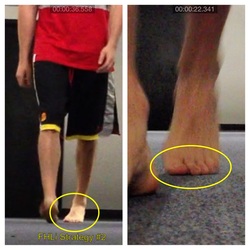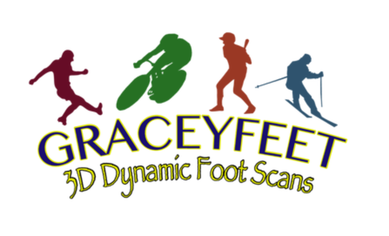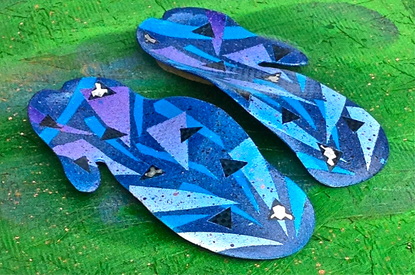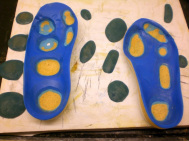|
In this episode of Living Healthy, I discuss who I am, some easy to understand concepts of the foot and ankle, and the Graceyfeet product line. What I did not have time for was to convey the understanding that the bridge between foot comfort and wellbeing extends beyond the physical and scientific theories described by scientists in peer-review journals. That my orthotics reach beyond the objective alignment of the joints and reduced foot pressures to touch the very soul of the wearer at the heart of their anxiety. Graceyfeet orthoses encourage a process of learning to recognize and observe (mind) the reactions and habitual patterns of a foot fall (body) and the resulting effort (breath) you extend during your functional day. Graceyfeet orthoses strive to align the bones, joints, and muscles, thereby enhancing strength and flexibility, balanced muscle action, and stamina and endurance. They are tuned to your perceived comfort and the more you wear them, the sooner you will discover the right balance between ease and effort in standing and walking. You'll be lengthening and contracting your muscles, aligning and gliding your joints, and quieting and soothing your nervous system as your Sole Commander orthoses guide your center of progression on its most correct path. They seek to bring about a mindfulness of motion.
Huge Hug and Thank You to Jay Greenstein and Barton Bishop for inviting me to come on and share my passion for making feet feel good. You may contact me by email ( graceyfeet@aol.com ) or at any one of the 7 Sport and Spine Rehab locations throughout the DC/MD/VA area. God is good, Peace be with you, and Namaste' Chris http://www.prweb.com/releases/2013/11/prweb11323572.htm Chris
0 Comments
 Volleyball, Basketball, Football, Track, Cheerleading...there are many sports that require an athlete to leap. Sometimes pain can occur in the ball of the big toe reducing the person's ability to perform to their desired capacity. Lost time off the court can hurt the team and in some cases, ruin a career. The scientific discussion below illustrates one of the problems that can occur in the foot. Plainly said, toe pain can be a product of poor alignment, stress, and overuse. A quality orthoses can correct the alignment, reduce stress, and restore pain-free balance. Hallux rigidus typically presents as an isolated arthritis in the adult without a systemic arthritic condition. This suggests the degenerative process is caused by some local pathologic alteration in the first MTPJ. The athlete with hallux rigidus usually complains of pain at this joint. He or she will often complain of stiffness and decreased motion with certain activities. Usually extension of this joint is limited, which reduces an athlete's ability to push off and causes them pain. Secondary joint degeneration may occur after a recognized traumatic event. Other theories suggest hallux rigidus is caused by extra strain on the first MTPJ in a pronated foot or by an elevated first metatarsal, resulting in a limitation of hallux dorsiflexion. In any case, the condition tends to be progressive. Normal range of dorsiflexion motion of the first MPJ should be 65 to 75 degrees in order to allow for a normal gait. Near the end of the propulsive phase of gait, the leg has a 45-degree position to the floor and the ankle is in about 20 degrees of plantarflexion to the leg. This position requires the hallux to be able to dorsiflex 65 degrees. Anything less requires accommodation or adaptation from the surrounding joints. This compensation can come from gait changes, such as subtalar joint supination and walking on the outside of the foot, subtalar joint pronation with foot abduction, etc. The treatment of hallux rigidus is aimed at reducing the local inflammatory process at the first MTPJ and decreasing the dorsiflexion forces that lead to painful dorsal impingement. The initial thrust should be to decrease the acute inflammatory reaction by emphasizing rest, NSAIDs and ice. Graceyfeet Sole Commander and Sole Supporter orthoses seek to relieve the painful forces by repositioning the 1st metatarsal head and spreading vertical forces towards the lateral foot. This allows for use of the client's full available ROM at the 1st MTP during forefoot loading in late stance phase of gait. Decreased pain and increased function are the results! Contact Chris at Graceyfeet@aol.com and chat with him about additional ways you can improve performance and prevent injury in your team. J Orthop Sports Phys Ther. 1999 Dec;29(12):727-35. Nonoperative and operative intervention for hallux rigidus.Nawoczenski DA. J Orthop Sports Phys Ther. 2009 Oct;39(10):733-42. doi: 10.2519/jospt.2009.3003. Structural factors associated with hallux limitus/rigidus: a systematic review of case control studies.Zammit GV, Menz HB, Munteanu SE. |
Chris Gracey MPT, Cped
Archives
October 2015
Categories
All
|
Follow Graceyfeet on Facebook and Twitter



 RSS Feed
RSS Feed
